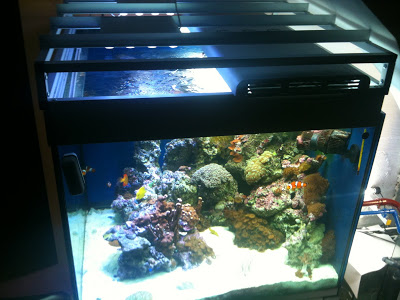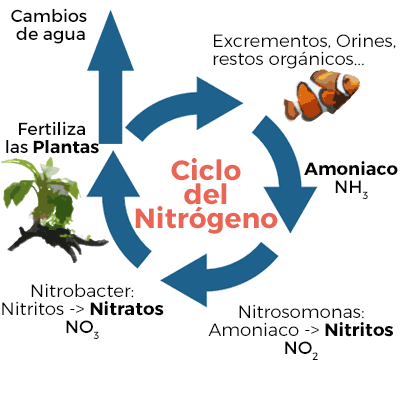Un acuario de arrecife mantiene una escasa población de peces. Algunos aficionados prefieren aproximarse más a las condiciones que aparecen en un arrecife de coral auténtico, en el cual un gran número de invertebrados dominan la escena, corales blandos y duros, anémonas, gusanos tubo, esponjas, estrellas de mar y crustáceos, entonces se produce una adicción espectacular al acuario, los peces, que son menos comunes en el arrecife de lo que mucha gente se cree. Un acuario de arrecife se acerca a la naturaleza tanto como puede, un escaso número de peces es necesario para mantener el delicado balance de un acuario de arrecife, que una mayor cantidad de peces podría destruir.
A reef aquarium maintains a sparse population of fish. Some amateurs prefer to get closer to the conditions that appear in an authentic coral reef, in which a large number of invertebrates dominate the scene, soft and hard corals, anemones, tube worms, sponges, starfish and crustaceans, then produced a spectacular addiction to the aquarium, the fish, which are less common on the reef than many people think. A reef aquarium approaches nature as much as it can, a small number of fish is necessary to maintain the delicate balance of a reef aquarium, which a larger amount of fish could destroy.

Los arrecifes de coral están confinados en latitudes tropicales (desde los 25 grados norte hasta los 25 grados sur) donde las temperaturas del agua se mantienen siempre por encima de los 20 º C. Numerosas especies de coral, otros invertebrados, varios microorganismos y ciertas algas construyen los masivos arrecifes calcáreos que proveen un sistema complejo que es la casa de un número increíble de invertebrados, peces y algas.
Los corales son actualmente anémonas y pólipos que colectivamente fabrican esqueletos de carbonato cálcico que forman trozos de arrecife. Muchos dependen de algas simbióticas (zooxantelas) contenidas bajo su piel y así están limitadas a aguas relativamente poco profundas.
Es importante comprender que los acuarios de arrecife no son duplicados exactos de los arrecifes de coral. Este medio ambiente natural contiene un sistema increíblemente complejo de interacciones entre todos los animales, plantas y microorganismos los cuales forman un ecosistema. Los arrecifes de coral forman el más complejo de los ecosistemas es imposible duplicar esto en los confines de un pequeño y cerrado acuario. Un acuario es un ecosistema incompleto que carece de muchos de los componentes alimenticios que se encuentran en un arrecife de coral natural. Se necesita la intervención regular del acuarista para mantener el acuario funcionando suavemente.
Coral reefs are confined in tropical latitudes (from 25 degrees north to 25 degrees south) where water temperatures always remain above 20 º C. Numerous species of coral, other invertebrates, several microorganisms and certain seaweed They build the massive calcareous reefs that provide a complex system that is home to an incredible number of invertebrates, fish and algae.
Corals are currently anemones and polyps that collectively make skeletons of calcium carbonate that form pieces of reef. Many depend on symbiotic algae (zooxanthellae) contained under their skin and thus are limited to relatively shallow waters.
It is important to understand that reef aquariums are not exact duplicates of coral reefs. This natural environment contains an incredibly complex system of interactions between all animals, plants and microorganisms which form an ecosystem. Coral reefs form the most complex of ecosystems; it is impossible to duplicate this in the confines of a small, enclosed aquarium. An aquarium is an incomplete ecosystem that lacks many of the food components found in a natural coral reef. Regular intervention by the aquarist is needed to keep the aquarium functioning smoothly.
CICLO DEL NITRÓGENO / CYCLE OF NITROGEN
Todo el mundo ha oído hablar del amoniaco, nitritos, bacterias nitrificantes, nitratos, amonio,… pero, ¿realmente todos conocemos como funciona esto? Voy a explicarlo de la forma más clara posible.
Los peces en el acuario excretan en forma de amoniaco y urea, los cuales combinados con el producido por los restos de alimento, restos de plantas y peces muertos. Todos estos restos producen Amoniacos (NH3) en condiciones aeróbicas (con oxigeno) y en condiciones sin oxigeno (anaerobicas) aparece aparte de amoniaco, ácido sullfhidrico, fenol, metano etc. todos muy tóxicos para los peces. Las zonas sin oxígeno se localizan principalmente en el sustrato, por lo que es necesario vigilar este punto.
En cuanto al Amoniaco (NH3) hay que saber que existe una forma disociada que es el Amonio (NH4) que es unas 100 veces menos tóxica que la forma gaseosa no disociada NH3. El que tengamos Amoniaco o Amonio se debe al pH y a la temperatura del agua, como más alto sea el pH y la temperatura, más Amoniaco tendremos, y al contrario, más Amonio; con un pH cercano a 8.2 y una temperatura de 25º tendremos un medio bastante seguro para nuestros peces en caso de una subida de Amoniacos, que al tener estos valores estaría en forma de Amonio. Lo que hace el Amoniaco al pez es que le provoca una hinchazón en las branquias, cuyas laminas se pegan provocándole la asfixia.
Everyone has heard about ammonia, nitrites, nitrifying bacteria, nitrates, ammonium, … but do we all really know how this works? I will explain it as clearly as possible. The fish in the aquarium excrete in the form of ammonia and urea, which combined with that produced by the remains of food, remains of dead plants and fish. All these remains produce Ammonia (NH3) in aerobic conditions (with oxygen) and in oxygen-free (anaerobic) conditions apart from ammonia, sullhydric acid, phenol, methane etc. all very toxic to fish. Zones without oxygen are located mainly in the substrate, so it is necessary to monitor this point. As for the Ammonia (NH3), it is necessary to know that there is a dissociated form which is Ammonium (NH4) which is about 100 times less toxic than the non-dissociated NH3 gas form. The one that we have Ammonia or Ammonium is due to the pH and to the temperature of the water, as higher is the pH and the temperature, more Ammonia we will have, and on the contrary, more Ammonium; with a pH close to 8.2 and a temperature of 25º we will have a fairly safe environment for our fish in case of a rise in Ammonia, which would have these values in the form of Ammonium. What the Ammonia does to the fish is that it causes a swelling in the gills, whose laminae stick together, causing it to suffocate.

Gracias a la presencia de bacterias nitrificantes empezara el proceso de transformación del Amoniaco o Amonio, de esto se encargan las bacterias Nitrosomas que consumen Amoniaco y Oxigeno y lo convierten en Nitrito (NO2) , Agua e Hidrogeno. Los Nitritos aunque no tan letales como el Amoniaco son igualmente peligrosos ya que se mezclan con la hemoglobina de la sangre y esta no puede llevar oxigeno provocando la asfixia de los peces.
Finalmente gracias a las bacterias Nitrobacter llevan a cabo la reacción de Nitrito (NO2) a Nitratos (NO3) consumiendo oxigeno, estos ya no representan ningún peligro en peces de agua dulce a no ser en concentraciones muy altas (1000 mg/l). Estos se eliminan porque los consumen las plantas, a través de cambios de agua (ojo con no poner agua que contenga más Nitratos que la que sacamos) también se puede utilizar un filtro desnitrificador, que convertiría los nitratos a nitrógeno libre. Este proceso lo llevan a cabo unas bacterias anaerobicas (que no necesitan oxigeno) utilizan el nitrato como alimento, cogiendo el oxigeno liberan el Nitrógeno, pero este proceso no puede darse dentro del acuario por razones obvias, entonces se debe acudir a un desnitrificador exterior.
Una vez conocido este proceso ya podemos saber que si tenemos Nitritos es que ha habido Amoniaco y si al revés tenemos Amoniacos tendremos Nitritos, a no ser que la colonia bacteriana ya este plenamente asentada y los productos tóxicos intermedios no aparezcan. Normalmente un acuario puede estar a pleno rendimiento a partir de un mes, más o menos, de su puesta en marcha; ahora bien un aumento excesivo de la densidad de animales, de los hábitos de comida, de sifonados excesivos, tratamientos con medicamentos, puede requerir otro proceso de maduración del acuario.
Un dato ha tener en cuenta es que en el agua hay como mucho un 1 o 2% del total de la colonia bacteriana del acuario. Ahora que ya sabe más comprenderá porque se recomienda ir poblando el acuario poco a poco, esto es simplemente para que las bacterias puedan ir adaptándose a la cantidad de peces que hay, y puedan absorber toda la materia orgánica que hay en el acuario.
Thanks to the presence of nitrifying bacteria, the Ammonia or Ammonium transformation process will begin, this is the responsibility of the Nitrosome bacteria that consume Ammonia and Oxygen and turn it into Nitrite (NO2), Water and Hydrogen. Nitrites, although not as lethal as ammonia, are equally dangerous because they mix with hemoglobin in the blood and it can not carry oxygen causing the fish to suffocate. Finally, thanks to the Nitrobacter bacteria carry out the reaction of Nitrite (NO2) to Nitrates (NO3) consuming oxygen, these no longer represent any danger in freshwater fish unless at very high concentrations (1000 mg / l). These are eliminated because the plants consume them, through water changes (eye with not putting water containing more Nitrates than the one we take out) you can also use a denitrifying filter, which would convert the nitrates to free nitrogen. This process is carried out by anaerobic bacteria (which do not need oxygen) use nitrate as food, taking oxygen to release nitrogen, but this process can not occur inside the aquarium for obvious reasons, then you must go to an external denitrifier. Once we know this process we can already know that if we have Nitrites, there has been Ammonia and if we have Ammonia, we will have Nitrites, unless the bacterial colony is already fully established and the intermediate toxic products do not appear. Normally an aquarium can be at full capacity from one month, more or less, from its start-up; however, an excessive increase in the density of animals, food habits, excessive siphoning, drug treatments, may require another process of maturation of the aquarium. A fact to keep in mind is that in the water there is at most 1 or 2% of the total bacterial colony of the aquarium. Now that you know more you will understand why it is recommended to populate the aquarium little by little, this is simply so that the bacteria can adapt to the amount of fish that there is, and can absorb all the organic matter that is in the aquarium.